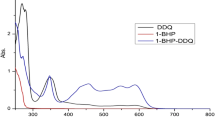Abstract
Charge-transfer interaction of picryl chloride with acenaphthene, biphenyl, m-terphenyl, o-xylene, and m-xylene is studied in CHCl3. Charge-transfer spectra of these complexes are examined spectrophotometrically. The formation of 1:1 molecular complexes is observed in each case. The association constant (K c ) and molar extinction coefficients (ε c ) of these complexes have been determined at the peak of the charge-transfer band usingKetelaar's equation. Charge-transfer transition energies (hv CT) when plotted against ionization potential of donor molecules gave almost a linear relation. Oscillator strength (f) and transition dipole moment (μ 2EN of these complexes have also been evaluated.
Zusammenfassung
Diese Arbeit befaßt sich mit den bei Ladungsübertragung auftretenden Wechselwirkungen von Pikrylchlorid mit Acenaphthen, Diphenyl, m-Terphenyl, o-Xylol und m-Xylol in CHCl3. Wir untersuchten spektrophotometrisch die Ladungsübertragungsspektren dieser Komplexe und stellten in jedem Fall die Bildung eines 1:1-Molekülkomplexes fest. Unter Verwendung derKetelaarschen Gleichung bestimmten wir die Assoziationskonstante (K c ) und die molaren Extinktionskoeffizienten (ε c ) dieser Komplexe im Peak der Ladungsübertragungsbande. Trägt man die Übergangsenergien bei der Ladungsübertragung (hv CT) gegen das Ionisierungspotential des Donormoleküls auf, zeigt sich eine nahezu lineare Abhängigkeit. Wir bestimmten ferner die Oszillatorstärke (f) und das Übergangsdipolmoment (μ 2EN ) dieser Komplexe.
Similar content being viewed by others
Literatur
S. D. Rose, M. Bassin, M. Finkelstein undW. A. Leach, J. Amer. Chem. Soc.76, 69 (1954).
H. M. Powell undG. Huse, J. Chem. Soc.1943, 435.
K. Nakamoto, J. Amer. Chem. Soc.74, 1739 (1952).
R. S. Mulliken, J. Amer. Chem. Soc.,72, 600;74, 811 (1952); J. Phys. Chem.56, 801 (1952).
R. D. Srivastava undP. D. Gupta, Indian J. Chem.6, 317 (1968).
J. A. A. Ketelaar, C. van de Stolpe, A. Goudsmit undW. Dzoubas, Rec. Trav. Chim. Pays-Bas71, 1104, (1952).
G. Briegleb, Electronen-Donator-Acceptor-Komplexe. Berlin-Göttingen-Heidelberg: Springer. 1961.
H. Mc Connel, J. S. Ham undJ. R. Platt, J. Chem. Phys.21, 66 (1953).
Author information
Authors and Affiliations
Rights and permissions
About this article
Cite this article
Srivastava, R.D., Srivastava, P.C. Untersuchung von Charge-transfer-Komplexen von Pikrylchlorid in Chloroform. Monatshefte für Chemie 103, 1033–1038 (1972). https://doi.org/10.1007/BF00905176
Received:
Issue Date:
DOI: https://doi.org/10.1007/BF00905176




